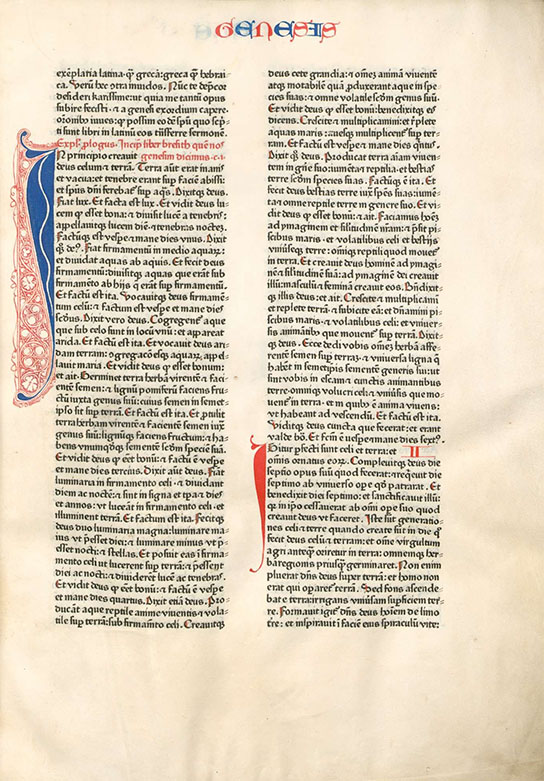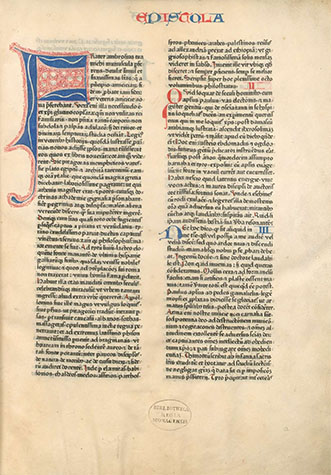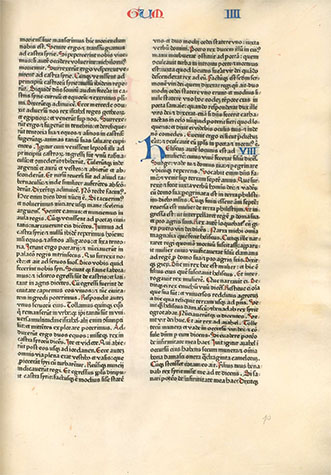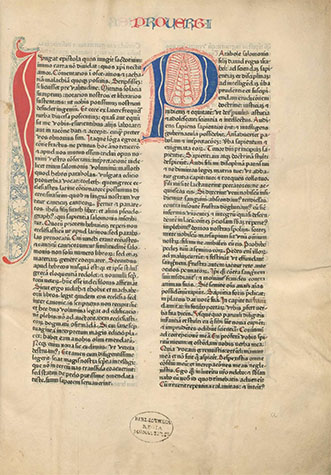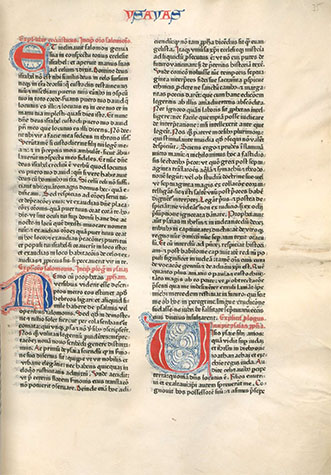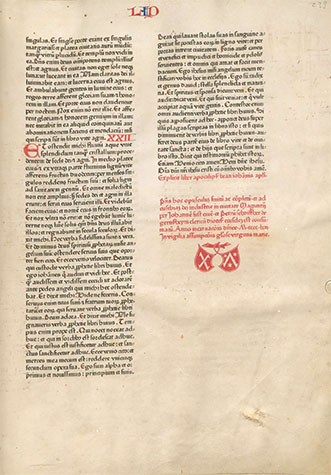vol.1, folio 14 recto, from ref. 1
81
Biblia Latina
Peter Schöffer and Gotico-Antiqua
This is Genesis 1–2 (In principio creavit Deus...) from Fust and Schöffer’s Biblia Latina. It was printed, according the the colophon, on 14 Aug 1462, making it the fourth printed Bible and the first to be dated.2 The 2-column 48-line Gotico-Antiqua text as well as the colored Lombard initials, chapter numerals and paragraph marks were all printed, rather than separately rubricated.
The masterful type design and page layout was immediately imitated (with less effect) by other German printers. It was, perhaps, more influential than Gutenberg’s 42-line Bible.
By the end of his work on the 42-line Bible (see here), Gutenberg was indebted to Fust to the tune of some 1550 guilders.3 What exactly Gutenberg had done with this money is unclear, but Fust sued him for principal + interest in Archbishop’s court in 1456 with Schöffer testifying for Fust.2 In the infamous Helmasperger Instrument of 9 Nov 1455 their partnership was dissolved. Fust had won the case and took possession of the Hof Humbrecht shop and the remaining Bibles. He quickly formed a new partnership with Schöffer and they became the first important printers in Germany.
Their first work was the remarkable Psalterium Benedictinum (AKA Mainz Psalter) published on 14 Aug 1457 – just two years after the 42-line Bible.3 It was the first book to include 2-color printing and two type sizes, as well as the first to include a colophon and a date. This was followed by Durandus’ Rationale divinorum officiorum (6 Oct 1459), and the 48-line Bible in 1462, the first book to include a printer’s device:
vol.1, folio 1 recto
vol.1, folio 137 recto
vol.2, folio 1 recto
vo1.2, folio 35 recto
vol.2, folio 239 recto, colophon
Fust died, probably of the plague, on a book-selling trip to Paris in Oct 1466 and Schöffer continued the enterprise alone. He printed theology treatises such as Thomas Aquinas’ Summa theologica (6 Mar 1467), and canon law books such Justinian’s Novellae constitutiones (21 Aug 1477). Later titles included the Herbarius (1484), the Missale Misnense and the Coronatio (both 1486). According to Lehmann-Haupt, Schöffer had printed 253 works (127 books) by the time of his death ca.1502. His press was continued by his son Johann until 1539.4
Over Schöffer's nearly 50-year career he cut nearly a dozen typefaces, but it was his earliest ones that were the most important. His first type (Schöffer Type 1, AKA Psalter type) for the Mainz Psalter was a textualis that was essentially a larger recutting of his B-42 type:
1459 psalter, f. 43r, Bayerische StaatsBiblothek
For the Rationale divinorum officiorum Schöffer cut a face based largely on his own calligraphy. The type (Schöffer Type 3, AKA Durandus), known as a Gotico-Antiqua or Fere Humanistica (“almost humanistic”) type, included less formal rounded letterforms. open counters and generous descenders. It was a bridge between the gothic textualis and the Italian humanist designs that would follow shortly.
f. 1r, Bayerische StaatsBiblothek
His type for the 48-line Bible (Schöffer Type 5, AKA 1462 Bible type) is widely considered his masterpiece. The font, which included 185 total characters, was a technically proficient and masterfully assured revision of his Durandus type:
Here are several later examples:
Cicero, De officiis, 1465. SMU
Herbarius, 1484. Missouri Botanical Garden
Coronatio Maximiliani, 1486.5 SMU
1. The Biblia Latina (ISTC ib00529000) was printed on Royal 2° paper or vellum folios (page size of 15¾ × 11¾") and was specifically divided in two volumes. Volume one (Genesis–Psalms) was 242 ff and volume two (Proverbs–Apocalypse) was 239 ff. Of the one hundred or so extant partial of complete copies more than half are on vellum. It is now the earliest Bible that still trades in private hands.
The images here are from the Bayerische StaatsBiblothek, via the Münchener DigitalisierungsZentrum, which has a complete vellum copy online. Here is the direct link to volume 1 and volume 2.
2. Here are the first three: the 42-line Biblia Latina (Mainz: Gutenberg, before Aug 1456), the 49-line Biblia Latina (Strasbourg: Johann Mentelin, ca.1460) and 36-line Biblia Latina (Bamberg: Albrecht Pfister, ca.1461). For more information see: The First Four Printed Bibles in the Scheide Library, available as a pdf.
3. For the record: principal + interest was 2026 guilders. Which, to your narrator, seems rather severely usurious.
4. For more on Schöffer see: Lehmann-Haupt, Hellmut. Peter Schoeffer of Gernsheim and Mainz. Rochester, New York: Leo Hart, 1950. Which is available online.
5. This one requires a litte explanation: Maximilian I of Habsburg (22 March 1459 – 12 January 1519) was elected King of the Romans (Rex Romanorum) on 16 Feb 1486 in Frankfurt am Main and coronated on 9 Apr 1486 in Aachen. Schöffer was tasked with the rather enviable job of printing the official coronation program. For the title page (above) he chose the original, and now 30-year old, B42 type, which he and Gutenberg used for the 42-line bible.
29 Dec 2010 ‧ Typographia Historia
